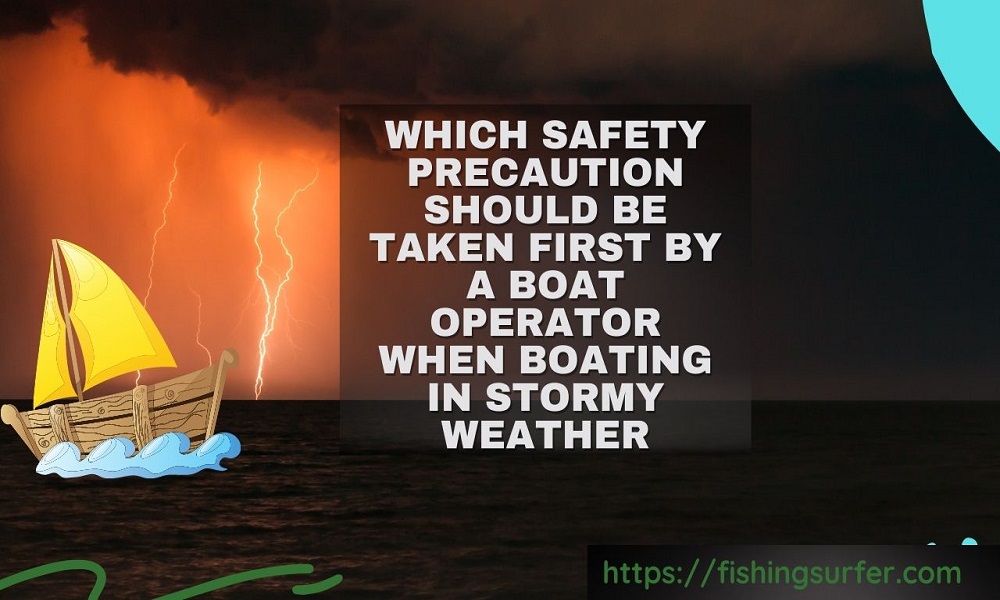When you’re on a boat, it’s easy enough to picture yourself sitting relaxedly while maybe you have a fly-fishing rod in one hand (and maybe a can of beer on the other hand). It’s just peaceful.
But then again, those are ideal circumstances, and you get those situations every time. Crap happens, and things can go wrong. A storm coming in can be very wrong indeed, and naturally you may ask: Which safety precaution should be taken first by a boat operator when boating in stormy weather?

The First Rule
While there are plenty of rules that can help you when you’re in a boat while a storm is raging, here’s the Prime Directive of them all: Everyone wears a life jacket.
As the boat operator, you’re basically the captain of the boat. If you have other passengers with you, it’s your job to make certain that everyone, without exception, is wearing their life jacket or any other sort of personal flotation device (PFD).
These PFDs must be approved by the US Coast Guard. Also, they should fit the wearer properly.
What about Babies?
You should be very careful when you have children on board your boat. Sometimes you may want to err on the side of caution, and restrict your minimum passenger age.
That’s especially true when babies are concerned. In fact, the US Coast Guard even recommends that if a baby weighs less than 18 pounds, it’s simply much more sensible that they don’t travel on any sort of boat in the first place. This is mainly because you can’t find life jackets in the proper size for babies who weigh less than 18 pounds.
Your baby can reach past 18 pounds at maybe 4 to 11 months of age. There’s really no law that says you mustn’t bring a baby on a boat, even if the baby weighs very little. But for goodness’ sake, use some common sense, okay? You really should just trust the experts in the US Coast Guard.
If you are the boat operator and you have a baby on board, you may want to leave the beer at home. It’s best if your boat is anchored, perhaps while you keep it in the marina or in the dock. If the boat has to move, keep the speed down to 6 mph. Stay in areas where waves and wakes can’t get at your boat.
Guidelines for Other Ages
If a passenger in your boat is under 6 years of age, they must wear a USCG-approved PFD (Type I, Type II, or Type III). This is required when the length of your boat is less than 26 feet.
But of course, you can play it safe and require all the kids on your boat to wear the USCG-approved PFD at all times, even when you have a bigger boat.
For children younger than 13 years old, they have to wear the USCG-approved PFD if the boat is moving and they’re on deck. They’re not really required to do this if they’re in an enclosed cabin, or below deck. But they should wear the PFD at all times regardless of where they are in the boat, if you have stormy weather to deal with.
But you can always play the “mean parent” role and require them to wear the PFD wherever they may be, even if the weather is nice. Kids can be very unpredictable, and you can’t expect them to stay in one place for long.
Additional Tips for Boating in Stormy Weather
Aside from the PFD guidelines, here are some other tips that should help you out.
- Before you set out on your boat, check the weather report. You should be ready for the likelihood of bad weather coming in, so that you’re not taken by surprise.
- Check your fuel tank. Better yet, fill ‘er up. You have to be ready for anything, because anything can happen in a storm.
- If a storm does come in unexpectedly, keep a cool head. If you panic, you’ll make bad decisions. Just imagine you’re Captain Picard or Captain James T. Kirk of the Enterprise. Better yet, pretend you’re Spock.
- As soon as the weather turns bad, wear your PFD immediately. Then make your passengers wear their PFDs as well. This is for everyone, regardless of age.
- Slow your vessel down and take stock of the situation.
- Secure all the loose items on deck, and below deck.
- Pay particular notice to the behavior of the waves on the water. With waves and wakes, approach them at an angle to minimize the risk.
- Now’s also not the time to resume drinking your beer. You want to be sober, and your passengers will just not trust you with a beer can in hand.
It may actually be a good idea to just not go on a boat trip if there’s a chance of stormy weather. If you do have to go out, then you better make sure that you have all the essentials on board. Aside from the life jackets for everyone, you need to have a fire extinguisher, a radio (and maybe even a backup radio), and distress flags and flares to attract attention.
Have everyone know what to do when someone goes overboard. Teach everyone, including the teenagers, how to use the fire extinguishers, VHF radio, and distress flags and flares.
Conclusion
It does seem like that the answer to the question “Which safety precaution should be taken first by a boat operator when boating in stormy weather?” is to not get caught in stormy weather in the first place. But if you do find yourself in a storm while boating, you better have a proper life jacket that fits. That’s the main rule for everyone on your boat, and as the captain it’s your job to keep them safe!
